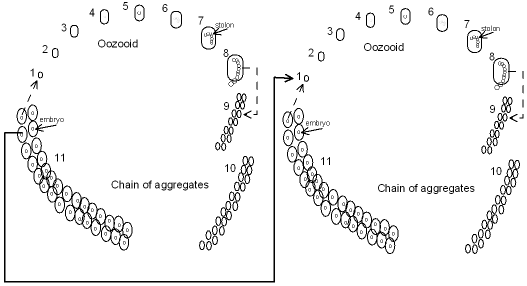
Salps
Computer scientists may need a few biological
explanations to understand the model. Salps (Fig. 1) are gelatinous animals
with a complicated life-cycle (Fig. 2). Individuals issued from the egg (or
oozooids) develop by asexual multiplication a stolon, which, by segmentation,
forms a chain of individuals (named aggregates, or blastozooids). Each
aggregate is about 1 cm long; a chain of 120 aggregates may measure more than
1 meter. Salps filter microscopic algae (phytoplankton) in the open ocean.
Swimmers on a beach have few opportunities to encounter salps.
 |
Fig. 1. A part of a chain of Salpa fusiformis. Four aggregates (blastozooids) are visible on this photograph (courtesy J.C. Braconnot). The black ovoid areas are the silhouettes of the digestive tracts (nucleus). Circular bands of muscles are disposed along the body. |

Fig.2. Life-cycle of Salpa fusiformis.
1 : Young
oozooid after liberation from the cloacal cavity of an aggregate.
4-8: A stolon develops in the oozooid (8: mature oozooid).
9 : The newly formed chain leaves the oozooid and growths (9-11).
11: The aggregates are fecundated; an egg develops which will give a newborn
oozooid in each aggregate.
There are many genera and species of salps. Large species may have oozooids up to 25 cm long, and long chains of aggregates may attain 40 m. RTS3 was originally build with Salpa fusiformis in mind, but only different parameters are needed to model other species with similar biology like S. aspera or Thalia democratica.
Vibilia
Vibilia armata (Fig. 3) is a small hyperiid amphipod that lives as a parasite (or more exactly as a parasitoid) on salps. A parasitoid is an obligate associate which eventually kills its host at the end of its development). Vibilia can only reproduce and grow on salps.

|
Fig. 3 Vibilia armata. A. Pantochelis larva
|
Problems with real salps
Salps are fragile planktonic organisms, difficult to keep in the laboratory. They are also difficult to sample correctly in the sea: long chains of aggregates may not enter the net, or may be broken during capture. The importance of their ecological role is increasingly recognized, but the above difficulties impede oceanographers in devising extensive experiments or sampling plans. Salps do not survive long enough in mesocosm, and their size range does not belong to the one accurately sampled by plankton nets.
The real organisms being not easily manageable, an alternative way would be to make computer simulations with 'software salps' resembling real ones. This model would permit to explore the consequences of research hypotheses without costly logistics. This model is not a mathematical model: mathematical models in ecology suffer from being too global, abstract, and integrative to be useful enough in a situation where many individuals move and behave independently in space. In contrast to mathematical modeling, simulations can use many parameters, and cope with nonlinear interactions of multiple autonomous individuals.
Return to home page
(Last modified 2007-01-22)